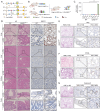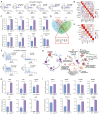GNGT1 remodels the tumor microenvironment and promotes immune escape through enhancing tumor stemness and modulating the fibrinogen beta chain-neutrophil extracellular trap signaling axis in lung adenocarcinoma
- PMID: 39958208
- PMCID: PMC11826275
- DOI: 10.21037/tlcr-2024-1200
GNGT1 remodels the tumor microenvironment and promotes immune escape through enhancing tumor stemness and modulating the fibrinogen beta chain-neutrophil extracellular trap signaling axis in lung adenocarcinoma
Abstract
Background: Despite the recent advancements in the treatment of cancer, the 5-year survival of patients with non-small cell lung cancer (NSCLC) remains unsatisfactory. Lung adenocarcinoma (LUAD) is NSCLC's most common subtype, and metastasis is the major cause of death in patients with cancer. Therefore, identifying novel targets associated with metastasis in NSCLC is crucial to improving treatment. This study aimed to characterize the expression of GNGT1 in LUAD and to clarify the mechanism underlying the association between the higher expression level of GNGT1 and worse prognosis in patients.
Methods: The transcriptome datasets and clinical information of patients with LUAD were obtained from The Cancer Genome Atlas (TCGA) and Gene Expression Omnibus (GEO) database. Bioinformatics analyses were performed in 515 patients who were stratified into two groups (high- and low-GNGT1 expression group) according to the GNGT1 level. Overall survival, DNA promotor methylation, immune cell infiltration, gene set enrichment analysis (GSEA), and Gene Ontology (GO) and Kyoto Encyclopedia of Genes and Genomes (KEGG) pathway enrichment analyses were performed to elucidate the functions of GNGT1 and to identify the related hub genes in LUAD. Their expression and functions in LUAD were verified using tissues from patients and transgenic mice overexpressing GNGT1 under the control of a lung-specific promoter (Scgb1a1-Cre).
Results: GNGT1 was overexpressed in patients with LUAD and was associated with poor prognosis. GNGT1 expression was significantly correlated with gene alteration and hypomethylated promoter status. High GNGT1 expression in patients with LUAD was associated with advanced lymph node metastasis and the degree of immune cell infiltration. Functional enrichment analyses indicated that differentially expressed genes (DEGs) in the high-GNGT1 group participated in DNA replication, DNA replication preinitiation, and M phase, while cell adhesion molecules, apoptosis, and natural killer cell-mediated cytotoxicity were all downregulated. Messenger RNA and protein levels were correspondingly regulated in human LUAD tissues and the Scgb1a1-Cre; LSL-GNGT1 mouse model (GNGT1fl/+ mice).
Conclusions: GNGT1 was associated with tumor cell proliferation via the enhancement of tumor cell stemness and interaction with driver genes. Elevated GNGT1 expression promoted epithelial-mesenchymal transformation, remodeled the tumor microenvironment, and led to tumor metastasis, ultimately worsening the survival-related prognosis of patients with LUAD.
Keywords: GNGT1; neutrophils extracellular traps (NETs); stemness; tumor microenvironment (TME).
Copyright © 2025 AME Publishing Company. All rights reserved.
Conflict of interest statement
Conflicts of Interest: All authors have completed the ICMJE uniform disclosure form (available at https://tlcr.amegroups.com/article/view/10.21037/tlcr-2024-1200/coif). R.A.d.M. serves as an unpaid editorial board member of Translational Lung Cancer Research from January 2024 to December 2025. The other authors have no conflicts of interest to declare.
Figures







References
LinkOut - more resources
Full Text Sources
Miscellaneous
